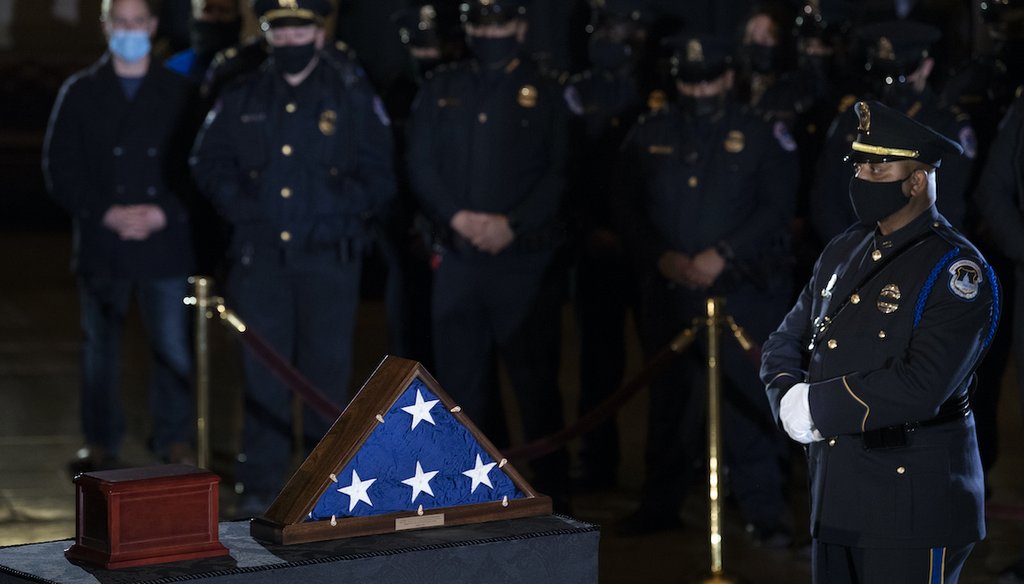Stand up for the facts!
Our only agenda is to publish the truth so you can be an informed participant in democracy.
We need your help.
I would like to contribute

U.S. Capitol Police officers pay their respects to the late U.S. Capitol Police officer Brian Sicknick as an urn with his cremated remains lies in honor in the Capitol Rotunda. (Brendan Smialowski/AP)
If Your Time is short
-
A full autopsy found that officer Brian Sicknick suffered two strokes after the Jan. 6 assault on the Capitol, with no sign that any injury or reaction to chemical irritants played a role.
-
Media coverage in the days after his death was of mixed accuracy.
New information from the chief medical examiner for the District of Columbia provides fresh details that call into question early reports about how U.S. Capitol Police officer Brian Sicknick died.
Sicknick died the day after the Jan. 6 assault on the Capitol. Initial reports, citing law enforcement sources, said that the 42-year-old had been struck on the head with a fire extinguisher. Follow-up coverage challenged that, saying he had been sprayed with a form of mace, and that the cause of death remained unclear.
On April 19, the medical examiner, Dr. Francisco J. Diaz, determined that Sicknick died from two strokes at the base of his brain caused by a blood clot in the artery that feeds that part of the body.
Diaz told the Washington Post that there were no signs of any injury, or evidence that Sicknick had an allergic reaction to chemical irritants. Sicknick died, Diaz said, of natural causes.
A look at news coverage surrounding Sicknick’s death shows how information about the circumstances of his death has evolved.
Sign up for PolitiFact texts
Here’s how the coverage of Sicknick’s death unfolded.
The Capitol Police announced Sicknick’s death in a Jan. 7 press release, writing that the officer died at roughly 9:30 p.m. "due to injuries sustained while on-duty." Sicknick, 42, was injured Jan. 6 "while physically engaging with protesters," the press release said. He collapsed after he returned to his division office and was taken to a local hospital, where he died.
On Jan. 8, the New York Times reported that he was struck with a fire extinguisher, citing two unnamed law enforcement officials as sources. This account of his death was cited in House Democrats’ Feb. 2 trial memorandum in advance of the impeachment of former President Donald Trump.
WUSA9, a local TV station, reported similar information, and that version of events took off on social media.
News anchors and talk show hosts, including CNN’s Anderson Cooper and MSNBC’s Rachel Maddow, repeated the story on air.
Ken Sicknick, the officer’s brother, told ProPublica that his brother texted him the night of the riot to say he was in "good shape" but had been pepper sprayed twice. But the next day, Jan. 7, Ken Sicknick and the rest of the family were informed that Brian Sicknick had experienced a blood clot and a stroke, according to the Jan. 8 ProPublica story.
The next day, Reuters reported that Charles Sicknick, the officer’s father, said his son was pepper sprayed and hit in the head. "He ended up with a clot on the brain," he said.
CNN reported Feb. 2 that medical examiners did not find signs that Sicknick had sustained any blunt-force trauma. Also citing an unnamed law enforcement official, CNN said investigators were struggling to build a case surrounding his death and were considering whether Sicknick became ill after interacting with a chemical irritant like pepper or bear spray.
The New York Times backed away from its initial reporting of Sicknick being struck on the head. In a Feb. 11 article during coverage of Trump’s second impeachment trial, the newspaper said, "Law enforcement officials initially said Mr. Sicknick was struck with a fire extinguisher, but weeks later, police sources and investigators were at odds over whether he was hit."
The Times’ correction prompted social media posts, op-eds and blog posts accusing the media of lying about the incident to exaggerate the violence against law enforcement.
"No police officer was ever beaten to death with a fire extinguisher," conservative activist Candace Owens wrote on Facebook.
Our Sources
Glenn Greenwald, The Media Lied Repeatedly About Officer Brian Sicknick's Death. And They Just Got Caught, April 19, 2021
The New York Times, "Officers’ Injuries, Including Concussions, Show Scope of Violence at Capitol Riot," Feb. 11, 2021
CNN, "New video helping investigators in search for suspects in US Capitol police officer's death," Feb. 10, 2021
CNN, "Investigators struggle to build murder case in death of US Capitol Police officer Brian Sicknick," Feb. 2, 2021
U.S. House of Representatives, "Trial Memorandum of the United States House of Representatives in the Impeachment Trial of President Donald J. Trump," Jan. 28, 2021
U.S. Justice Department, "Press Conference," Jan. 26, 2021
Reuters, "U.S. Capitol police officer who died after violent assault 'loved his job,'" Jan. 9, 2021
ProPublica, "’This Political Climate Got My Brother Killed’: Officer Brian Sicknick Died Defending the Capitol. His Family Waits for Answers," Jan. 8, 2021
The New York Times, "Capitol Police Officer Dies From Injuries in Pro-Trump Rampage," Jan. 8, 2021
The New York Times, "He Dreamed of Being a Police Officer, Then Was Killed by a Pro-Trump Mob," Jan. 8, 2021
WUSA9, "US Capitol Police officer dies after being injured during Capitol riots," Jan. 7, 2021
U.S. Capitol Police, "Loss of USCP Officer Brian D. Sicknick," Jan. 7, 2021
Candace Owens on Facebook (archived), Feb. 17, 2021
PolitiFact, What we know about Capitol Police officer Brian Sicknick’s death, Feb. 22, 2021





















































